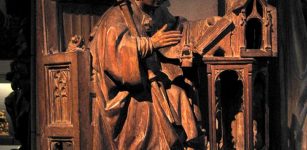Deciphered Ancient Tablet May Depict Biblical Tower Of Babel – New Evidence
A. Sutherland - AncientPages.com - Researchers have deciphered an ancient tablet believed to depict the Biblical Tower of Babel that stood in Babylon during Biblical times.
The tablet, which was discovered a century ago, was never studied or exhibited until now, reports Breaking Israel News.
But this amazing artifact dated to the 6th century BC, tells the story of the Babylonian tower, which was considered to be a work of fiction.
Dr. Andrew George, a professor of Babylonian at the University of London and an expert on ancient Babylon, deciphered the tablet and examined an image of the ziggurat, a massive stepped structure and a figure holding a staff.
Researcher translated the inscription, which identifies the structure as the “Tower of Temple of Babylon”.
The inscription confirms the building was a Mesopotamian-style tower and illustrates the seven tiers of the ancient megastructure. It also identifies the man behind it, depicted next to the tower - King Nebuchadnezzar II, ruler of Babylon c. 605 BC – c. 562 BC, who had the longest reign of any king of the Neo-Babylonian empire.
A detailed account on the tablet reads as follows:
“It reads, ‘from the Upper Sea, which is the Mediterranean, to the Lower Sea, which is the Persian Gulf, the far-flung lands and the teeming people of the habitations, I mobilized in order to construct this building.”
Gradually more and more archaeologists find proof that Biblical stories relate to events that really happened. The story recorded on the ancient tablet is one of them. Therefore Dr. George sees no contradiction between science and the Bible.
“After Darwin cast a doubt on the story of a six-day creation, people began to ask what else in the Bible might not be true,” Dr. George said. “In the 19th century there was a discovery that the Assyrian kings described in the Bible were real and corroborated by archaeological evidence, making us ask now, how much more in the Bible is true?”
Read more – here.
Nebuchadnezzar’s ziggurat, commonly referred to as the E-temen-an-ki ("House of the foundation of heaven on earth"), was the large temple tower, believed to be about 300 feet (91 meters) tall, with a square base measuring 300 feet on each side. It covered the earlier structure, made of sunbaked bricks, inside a 49-foot -thick wall of oven-baked brick.
Etemenanki was completed in the sixth century B.C.E. The structure was dedicated to the patron god of Babylon, known as Marduk.
Written by – A. Sutherland - AncientPages.com Senior Staff Writer























